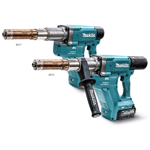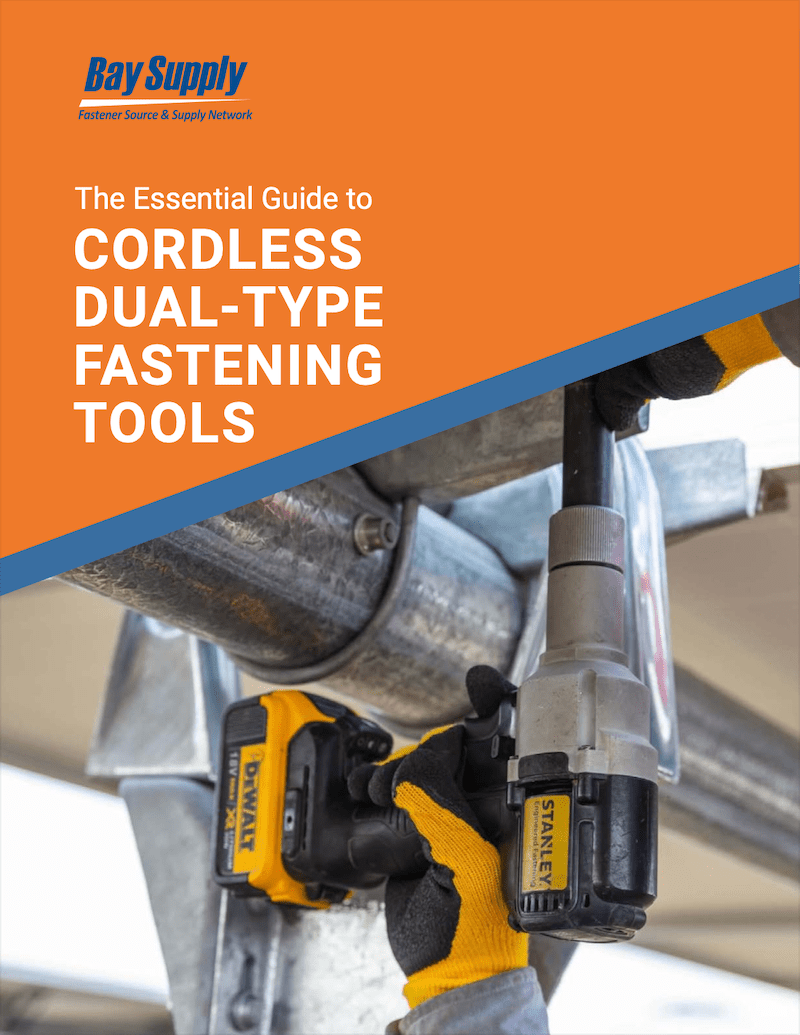Fastening toolmakers continue to expand their catalogs of battery-powered tools. The best cordless tool brands are improving their existing tool designs to take advantage of innovations in battery technology, and they are developing lighter and more powerful portable tools. Here are a few innovations we have seen hit the market in recent months.
Huck
Developed by Makita and Arconic Fastening Systems, The Huck BV13 and BV17 are the newest additions to the RangeForce line of battery tools, offering 13,000 and 17,000 pounds of force, so they can install most Huck fasteners without the need for pneumatic or hydraulic power.
The BV13 is for HuckBolts, and the BV17 is for blind fasteners from 5/16 inches up to ½ inch in diameter. These units use 40 V Li-ion batteries with an approximate recharge time of 28 minutes for the 4-ampere hour (Ah) battery and 40 minutes for the 5 Ah battery. They weigh about 16-18 pounds, depending on the battery.
The Huck BV2200 and BV4500 RangeForce tools have been gaining popularity among solar installers. These tools use an 18 V 5 Ah battery and can handle blind rivets and lockbolts from 3/16 inches to 1/4 inches and feature a stroke length of 1.18 inches. The BV2200 has a pull force of up to 2,200 pounds and can be electronically adjusted for pull force ranges from 392-2,200 pounds by pressing a button at the base of the tool. The BV4500 has a pull force of 4,500 pounds and is adjustable from 400-4,500 pounds, depending on the set point. They weigh between 4-6 pounds.

Goebel
Goebel, the German tool manufacturer, has introduced the Goebel GO-LB1, a cordless lockbolt tool with an 18 V Li-ion battery, to compete with American toolmakers at the low end of the market. The GO-LB1 is a lightweight tool at 3.3 pounds and is designed for 3/16-inch and ¼-inch nose assemblies with a 9.65- by 10.24-inch pull stroke.
Gesipa
German tool manufacturer Gesipa is one of Europe's leaders driving CAS battery standardization. The company’s BirdPro tool series takes full advantage of the CAS interchangeable battery system, offering seven models with 18 V battery power. Li-ion batteries are available in both 2 Ah and 4 Ah configurations.
The BirdPro series covers a wide range of applications. For example, the AccuBird Pro has seven nose assemblies, the PowerBird Pro Gold tool handles extra-strong fasteners, and the iBird Pro C has setting process monitoring. There are also options to adjust the setting force and stroke.
Gesipa is taking the lead in developing smaller portable fastening tools, such as the Gesipa Birdie. The Birdie is being billed as the smallest, lightest battery-powered riveting tool in its class. The Birdie weighs less than 2 pounds without the battery and is designed for long-term use with less fatigue. It can be used for a wide range of applications, handling blind rivets up to 3/16 inch with a pull force of 2,250 pounds and a pull stroke of 1 inch. Like most battery-powered units in this class, the Birdie features a brushless motor that makes it virtually maintenance-free. It also has a spent mandrel container.
Stanley
To compete with the Huck BobTail, Stanley offers the PB2500N cordless NeoBolt tool for ¼-inch and 5/16-inch lockbolts. This tool has a DeWalt 20 V 4 Ah battery for more power, and the DeWalt charger offers a 30-minute recharge time. The PB2500N has a pull force of 2,000 pounds, a stroke of 1 inch, and weighs a little more than 5 pounds.
Stanley’s also offers smart riveting tools. The PB2500 smart rivet tool can install 1,100 steel 3/16-inch open-end fasteners with a single battery charge. What makes the tool “smart” is an onboard touchscreen process monitoring system that includes an OK/not OK notification for each rivet installation. The unit has a capacity for 500,000 settings and has Wi-Fi and Bluetooth connectivity.
The BR12PP-8 process monitoring smart blind rivet tool is fully programmable and sets 1/8-inch to 3/16-inch rivets. This battery-powered rivet gun has an onboard display and can be programmed for advanced error-proofing, such as rivet count, job selection, and connection to user error-proofing systems. It has onboard storage for up to 500 rivet pulls, tracking force, distances, speed, current, and bus voltage, and data can be readily exported for analysis. The BR12PP-8 can be configured using a barcode reader for up to 16 job profiles for multiple rivet types of application thicknesses.
The SB25PT-05 is Stanley’s battery-powered speed fastening tool which can install 800 3/16-inch steel NeoSpeed fasteners on a single battery charge. This tool has a long barrel design for easy access in tight spaces and uses DeWalt Li-ion batteries with fast charging times and quick-change nose jaw and tail jaw systems to cut downtime.
Lobster
Japanese toolmaker Lobster offers the R1B1 and R1B2. These units operate on a 14.4V battery and are very fast, making them ideal for use in a factory or production environment. They also have a 2,361-pound pull capacity and a 0.866-inch stroke.
Lobster tools have an ergonomic design and weigh 4.19 pounds, making them ideal for long-term use. They are energy-efficient, so they can install more rivets on a single charge. Added features include an LED spotlight to illuminate the application area, increased capacity for mandrel collection, and a power-disabling safety device.
FAR
Italian manufacturer FAR has developed a new line of portable rivet tools that use 16V and 20V Li-ion batteries. The FAR EB 500 features a 16 V 2 Ah battery and is designed to handle 3/32-inch to 3/16-inch rivets. It has a pull force of 2,248 pounds and a 0.827-inch stroke.
The FAR EB 640 can handle 3/16-inch t0 5/16-inch rivets and has a 20 V 4 Ah Li-ion battery. It has a pull force of 4,496 pounds and a 1.181-inch stroke.
Marson
Marson offers the BT5 and the BT6, both highly affordable portable rivet tools that operate on 18 V 2 Ah batteries.
The Marson BT5 rivet gun handles 3/32-inch to 3/16-inch blind rivets with a 0.866-inch stroke and a pull force of 2,248 pounds. The tool weighs 4.21 pounds with the battery pack, and the battery has a recharge time of 45 minutes.
The Marson BT6 cordless tool has tips for ¼-inch and 3/16-inch rivets with a 1.024-inch stroke and a pull pressure of 4,496 pounds. The BT6 weighs 4.28 pounds, including the battery.
Huck Cordless Power Rig
The Huck 964B Powerig falls into its own portable tool category. While other portable tools use rechargeable batteries to power the tool, the Huck 964B Powerig is a battery-powered hydraulic power system designed for low-volume use, such as field repairs.
What makes the 964B innovative is that it makes hydraulic power portable. With this battery-operated Powerig, no external cords or power sources are needed, which means no gas pump or noisy electrical generators on a jobsite or where you need to make a repair in an area without power. The 964B connects and operates like any other hydraulic system, so you have access to the full range of hydraulic tools and nose assemblies, including those you may need for big jobs, such as railroad repairs, construction site use, large equipment repairs, and more.
The 964B Powerig is ideal for large-diameter fasteners such as the C50L lockbolt, the Huckspin2, and BobTail fasteners. It uses an 18 V 9 Ah Li-ion battery and features a motor speed of 7,000 rpm. The reservoir capacity is 70 cubic inches, and the unit can reach 10,000 PSI with adjustable pressure relief valves to control pull and return pressures.
It doesn’t operate as quickly as conventional hydraulic systems, which is why it is useful for low-volume use. However, it is highly portable since the entire unit weighs 74.5 pounds when the reservoir is full, so you can use it virtually anywhere.
 Howmet Aerospace and Huck recently launched these first-of-its-kind cordless lockbolt tools. Check them out!
Howmet Aerospace and Huck recently launched these first-of-its-kind cordless lockbolt tools. Check them out!

